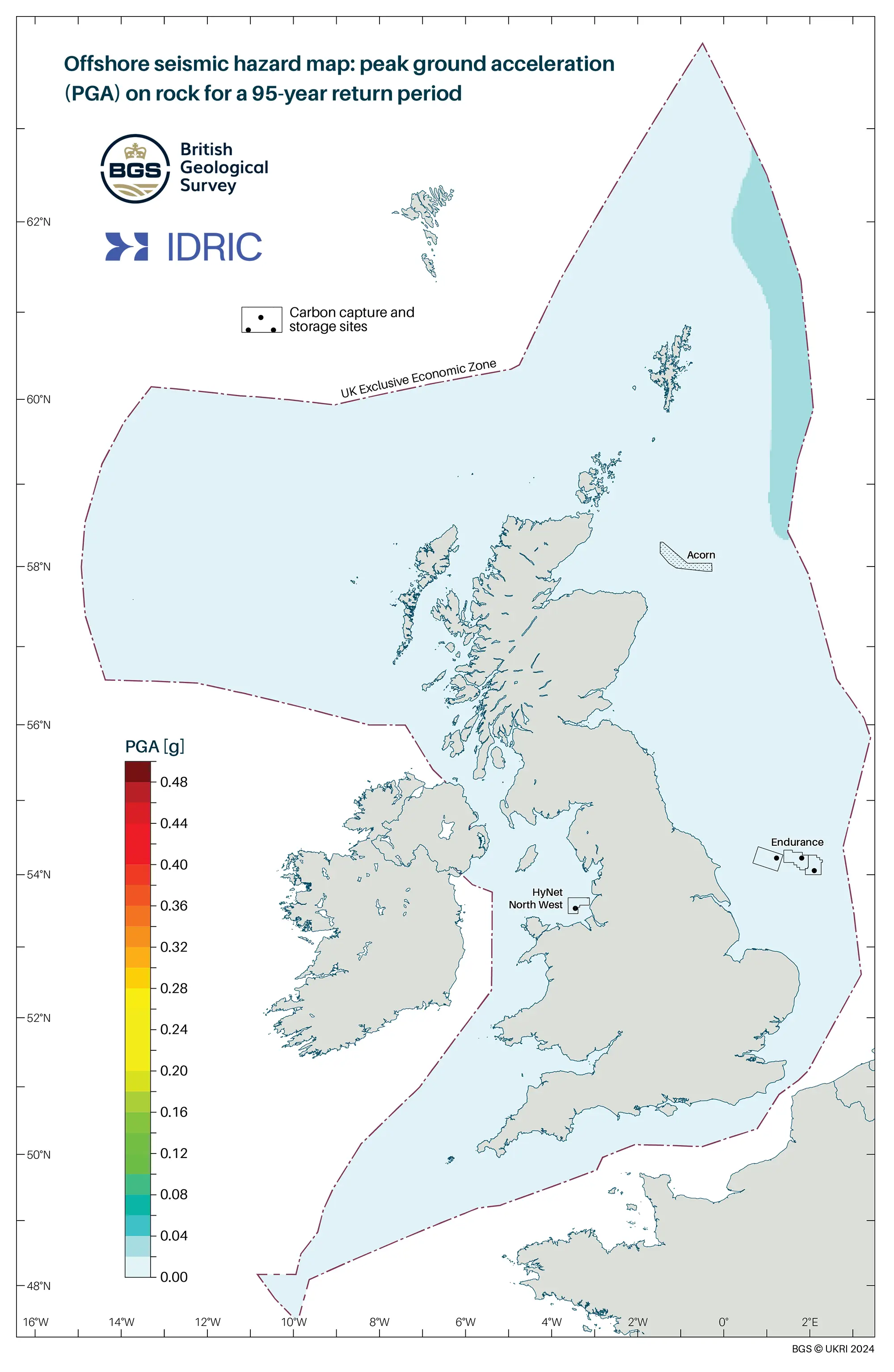Offshore seismic Hazard in UK waters
To meet the net zero carbon commitments, the North Sea and the Irish Sea have a strategic role in achieving this target with an increasing number of licensed carbon capture and storage sites. The presence of historical seismicity, including the largest earthquake ever recorded earthquake in the UK (6.1 local magnitude in 1931 in the southern North Sea), suggests that it is important to quantify the seismic hazard earthquakes pose to the built environment in UK waters so that high consequence offshore structures can be designed appropriately to reduce risks to people and the environment. BGS seismologists have recently completed a new seismic hazard assessment for the UK Offshore Exclusive Economic Zone (EEZ). This has been undertaken with support from the Industrial Decarbonisation Research and Innovation Centre (IDRIC).
The seismic hazard is computed using a model that aims to characterise the relevant earthquake processes and effects in a region. It consists of two parts: one that characterises earthquake occurrence in space and time (where they occur and their frequency of occurrence, sometimes referred to as the seismic source characterisation model) and another that describes the ground shaking that may result from potential future earthquakes (the ground motion characterisation component). The model is based on historical and instrumental observations of earthquakes and their effects, and information and data relating to the tectonics and geological structure of the UK region. The modelling must also try to capture the uncertainty relating to both the natural randomness of the earthquake process and to limited data and knowledge about different aspects of earthquakes and their effects.
The new offshore seismic hazard maps are given for three ground motion measures: peak ground acceleration (PGA) and spectral acceleration (SA) at 0.2 s (5 Hz) and 1.0 s (1.0 Hz) (assuming 5% damping). They show these results for rock conditions (time-averaged shear wave velocity for the top 30 m, Vs30, of 800 m/s) and have been computed for four return periods: 95, 475, 1100, 2475, and 5000 years. These return periods correspond to probabilities of approximately 41%, 10%, 5%, 2%, and 1% respectively, of exceeding a particular level of ground motion in a 50-year period (the typical service life of a building). For example, for a return period of 475 years, the maps show that the PGA hazard is about 0.04 g for much of the UK offshore EEZ. This can also be described as there being a 10% chance of a particular location experiencing a PGA value higher than 0.04 g in any 50-year time period.
The maps confirm that seismic hazard is generally low in UK waters but that the hazard is slightly higher in areas like the Irish Sea close to North Wales, the northern North Sea and the southern North Sea immediately offshore Lincolnshire and East Anglia. This largely reflects the higher rates of historical earthquake activity in these regions.
The technical report describing the development of the maps, and the data files containing the main elements of the model and key datasets are below.
Please note that these hazard maps are not a substitute for a site-specific hazard assessment should one be required. The user must take responsibility for checking that use of the results contained in this report is appropriate for the case in question.
Data and Model and Output files
Aavailable via the National Geophysical Data Centre HERE
Please cite this data using the following reference:
Mosca, I., Baptie, B., Haslam, R., Gafeira, J., Jenkins, G. (2025). Offshore seismic hazard models and maps for the UK Exclusive Economic Zone. NERC EDS National Geoscience Data Centre. (Dataset). https://doi.org/10.5285/a6babafa-5c82-4e76-aef5-27441104187f
Seismic hazard maps

*Page updated 24/1/25 to include updated seismic hazard maps


